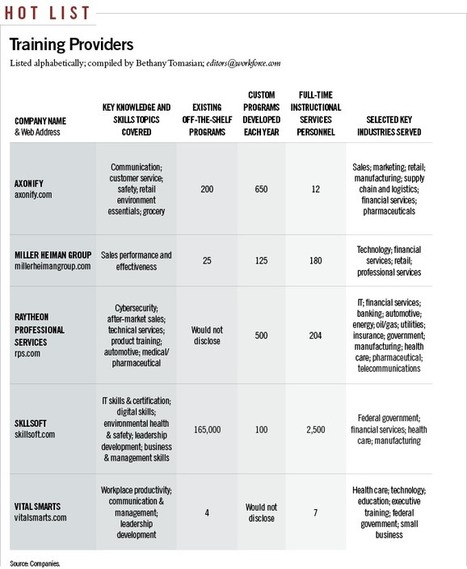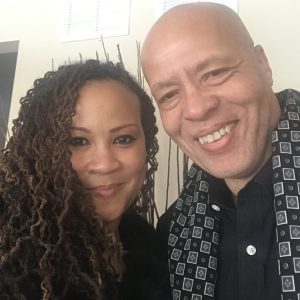 Your new post is loading...
 Your new post is loading...
5 Ways to Improve Workplace Culture
By Makeba C. Butler Founder and Principle of MCB Educational Solutions, LLC The word culture has become a highly discussed topic over the past 20 years, but is it as important as many have made it out to be? Giving credence to the word that everyone loves to explore, culture represents the soul of an organization. A great culture attracts the most highly sought-after talent, drives engagement, increases productivity, and grows the impact of an organization tremendously; but is a positive culture enough? Many organizations invest large amounts of money to learn how to create dynamic workplace environments. One benefit of acknowledging the perks of a positive workplace culture is creating an environment that allows employees to represent the organization well where employees feel appreciated and valued. Establishing a positive workplace culture is an intentional decision that requires leadership. It is not something that should be left to happenstance but rather built through values, beliefs, and ideals that best describe how an organization functions on a daily basis. By having these ideals in place, organizations can design organization strategies and activities that align with and support positive cultures. So, what exactly impacts workplace culture and how can organizations define theirs effectively? - An organization’s people– its human capital – have the greatest impact on organizational culture. Because of this, it is imperative that leadership hires individuals who can support and foster the values, beliefs, and ideals set by the organization.
- The management team most assuredly plays the largest role in how culture impacts an organization. Because management is tasked to carry out the cultural objectives of an organization, it makes sense to focus time and effort on selecting managers who have a desire to see employees be happy. It is important that management keeps organizational culture at the heart of everything it does.
- The physical workplace environment is another critical factor when it comes to workplace culture. Most employees spend a significant amount of time in the office, so making sure that the environment is free from clutter or uninviting spaces plays a large role in establishing positive workplace culture. Some companies like Google and Groupon go out of their way to establish aesthetically pleasing and employee-centered workplace environments.
- Policies & Procedures play a major role in establishing a conducive and impactful workplace culture. Organizations should be careful not to impose policies and procedures that are adverse to the mission of the organization. Especially if those policies and procedures impact employee retention and morale. The mission of the company can’t be so impactful externally that internally it poses a threat to the employees who work there.
- Finally, communication anywhere is the connector everywhere. No workplace culture can be its best without a useful and deliberate communication strategy in place. Management must communicate well externally and internally. Employees and other stakeholders must know the most important and pressing issues concerning the organization’s mission, vision, and strategic plan. A positive workplace culture allows employees to communicate without fear of retaliation or disparaging feedback.
Teaching organizations how to leverage effective strategies that can improve their cultures is a win-win for everyone. In a world full of millennials and Gen Z’ers who will jump ship quickly if they aren’t getting what they need, organizations understand focusing on retention is far better than compromising good employees. The good news is that creating a positive workplace culture is an ongoing work in progress – cultures can and do change over time. If a culture is broken, fix it, but never leave it broken. Makeba C. Butleri s the Founding Principal of MCB Educational Solutions, LLC and the 360 Consulting Group- an education consulting firm providing professional development and parent education training on social & emotional intelligence, relationship-building, teacher and leader effectiveness, and student proficiency. Makeba provides cultural competency training and consulting services to educational and community-based organizations servicing students of color and diverse populations. To learn more about Makeba, visit https://www.e-es.co.
Executives and employees are clamoring for more training, and learning leaders are more than happy to oblige.
Capability Academies, the next step in corporate training. Designed for the Future of Work.
An instructional design career offers many paths you can follow from designing workplace training to curreiculum development for a school system.
Greta Roberts offers five important steps to follow when selecting a predictive talent analytics project.
The Power of Storytelling
By Anna Manning ATDChi Intern As an English major and lover of books, I have always had a passion for storytelling. Despite this love, I was not aware that storytelling had a role within the professional sphere and my future profession. Since interning with ATD Chicagoland Chapter (ATDChi), I have learned how powerful of a tool storytelling is for developing people. This realization now makes complete sense to me. As children, most of our knowledge is taught to us through a storytelling format. Through stories, teachers and parents are able to explain complex and abstract ideas in an engaging and example-driven fashion. The stories are memorable and peak children’s interest in learning which reminds me of own childhood. Early on, I struggled to keep up with my classmates in all subjects but especially reading. My teachers and parents tried reading games and special reading classes, but I quickly grew bored and was not able or willing to focus. Through their reading captivating and emotionally appealing stories to me, I developed a motivation to learn to read on my own. This summer, I became interested in how to effectively use storytelling both in my life as a college student and as a full-time employee. In a study done by Pual Zak from Harvard Business School, Zak discovered “…that character-driven stories with emotional content result in a better understanding of the key points a speaker wishes to make and enable better recall of these points weeks later. In terms of making an impact, this blows the standard PowerPoint presentation to bits.” Based on Zak’s research, I believe that if companies taught through stories rather than just standard presentations, employees would be more engaged and remember content better. I can see using this tactic when doing presentations – adding a personal story at the beginning of a presentation to initially engage an audience or sharing a story to highlight a key point to increase recall. One company that uses storytelling to introduce the behaviors and norms they want their employees to follow is Salesforce. By using the idea of “Ohana” a Hawaiian ideal that encompasses the idea “…that families – related or chosen – are bound together and that members feel a sense of responsibility for one another…,” Salesforce has created an emotional connection with their employees. In this way, Salesforce makes use of Zak’s research in which an emotional connection has a much longer-lasting impact than a simple presentation. My eyes are now open to the power of storytelling and its ability to engage employees in a fun and creative fashion. I can’t wait to practice using this skill within my own life as a student and eventually as a professional. My experience as the ATD Chicagoland Intern has given me great exposure into an abundance of Talent Development insights, including storytelling, for which I am deeply grateful. Anna Manning is a rising Junior at St. Olaf College in Minnesota. She is majoring in English with a concentration in Management Studies. Anna is currently interning with ATD Chicagoland and is focused on aiding their Marketing Team while learning more about Human Resources. References: Zak, Paul J. “Why Your Brain Loves Good Storytelling.” Harvard Business Review, 5 Nov. 2014, hbr.org/2014/10/why-your-brain-loves-good-storytelling. “How We've Made Salesforce a Great Place to Work.” Salesforce Blog, www.salesforce.com/blog/2016/03/best-place-to-work-salesforce-2016.html.
Self-Management: A Critical Skill Every Leader should Master
By Sean Bailey, Ed.D., CPLP What if I told you that setting goals was a waste of time? Most people would probably disagree on the surface. So let’s take a deeper look. The fact of the matter is that according to several studies over the past half-century (1979, Harvard Business School, 2014 Univ of Scranton, 2018 Forbes) roughly 15% of individuals actually set goals. Of the 15%, 84% fail to realize their goals. What’s more alarming; the 85% that don’t set goals or the 84% that fail to reach their goals? What we know is that goal setting has always been a performance “buzz word” used by many of us in work and life to help staff, colleagues, friends, and family understand our future selves better. Where we fall short is not in the motivation of reaching goals but in the clarity of how we’ll get there. Here’s a thought, instead of just writing down goals, focus on the systems or components that make goals more attainable. In my opinion, the two key components are habits and mindset; which also happen to be two essential elements to self-management. So, this article is really about self-management, but I had to get your attention somehow. Did you know that 75% of baseball players that come to bat make an out? The MLB league average in 2016 was .255, and the all-time league average is between .260 and .275 (2018, MLB). Does that mean that each batter didn’t set a goal of making a hit, scoring a run, or winning the game? Of course not! It would be easy to argue that every player on the field has a goal of winning the game. So if goal setting is so important, why doesn’t everyone win? Simply put,we’re focusing on the wrong things!We want staff to write down goals and spend considerable time articulating the perfect attainable goals so that we can review and hold them accountable for those goals at an annual review. But, if we took those written down goals, unpacked them, and put an equal, if not greater amount of emphasis on building better habits and developing a better mindset, could we impact the way we work and realize success? Self-management is more about the systems of our habits that make attaining those goals obvious, attractive, easier, and rewarding. Now, I must give credit to the groundbreaking best seller James Clear on his publication of Atomic Habits. But in my years of research on self-management and its role in developing better emotional intelligence, I’ve found that only 5% of the 15% of those who set goals spend the necessary time working on the mechanics of habits and mindset. There’s no question as to why 85% or more goals fail. So, here’s some practical solutions to help bridge the gap between goal setting, success in reaching those goals, and building better self-management skills. Oh, and did I mention that self-management is considered a top critical skill for today’s jobs and tomorrow’s employability (Wolfe, 2017). Okay, so try the following. First, unpack a written goal into a minimum of (7) pieces. There’s no empirical evidence to suggest the number seven, but what I have found is that people tend to focus better when they can shoot for a challenging lucky number. For example: My goal is to write a book. I would unpack that goal with the following questions: - What do I want to write about?
- Where do I like to write?
- What time would be the best time for me to write?
- How long should I write in one sitting?
- How often do I read others’ writings?
- What will be some milestones for my writing?
- Who will I ask to read my drafts?
What I’ve come to realize in all the years I’ve spent developing leaders, including myself, is that lack of clarity about how to achieve goals is what actually debilitates motivation. Notice the unpacking of the steps never mentioned when I would have the book finished, when I would get it published, when I will have a book signing, etc. Why? Remember the first component that I mentioned earlier; habits! Unpacking goals allows you to put more emphasis into the systemsthat develop better or “good” habits. Learn to place more focus into each line item in your unpacking and the end result will be better. Once I determine what I wantto write about, I can better clarifywhere I like to write (i.e. library, kitchen table, etc.). Then I can work on the best time for me to write (8 - 8:30 am on a Tuesday or 7 - 7:15 pm on a Thursday). How longshould I write then becomes a question of how easy do I want to make my habit (1 sentence, 2 minutes, 1 paragraph). What you are doing is making choices, clarifying your path, fine-tuning your systems. You are making every line item in your “unpacking” 1% better. Next, as you develop your habits, you’re also developing your mindset. Small victories create amazing strides in our brain chemistry. According to one of my brilliant colleagues, modeling successful processes is important (Belenky, 2018). Dr. Belenky’s work goes on to state, “normalizing certain behavioral patterns, like struggle leading to success, and feeling energized and challenged, can help improve outcomes.” In other words, Belenky was referring to having a growth mindset and that is associated with more learning-oriented goals, greater persistence, better learning strategies, and, ultimately, achievement (see Yeager & Dweck, 2012). So now you’ve got both components working in your favor. Put more emphasis into these systems and take note of the improvements to your self-management skills. So I ask you again, what If I told you that setting goals was a waste of time? Dr. Sean Bailey is the CEO & President for BCG-North America Corporation, an organizational consulting and corporate training company. He is a researcher, trainer, leadership coach, and speaker. He specializes in product and process improvement, professional development, and evidence-based learning design supporting company leaders in improving the effectiveness of their training & development pedagogy. He often speaks about self-management and improving personal systems to help develop productive habits and a growth mindset. To learn more about how you can use self-management research to improve individual and team effectiveness, contact Dr. Bailey at sbailey@bcg-northamerica.comor via Facebook @bcg.northamerica. References: Belenky, D. (2018). Motivation and Mindset. Pearson[1]. Clear, J. (2018). Atomic Habits: An Easy & Proven Way to Build Good Habits & Break Bad Ones. New York, NY: Avery. Harvard Business School. (1979). Have you set clear, written goals for your future and made plans to accomplish them? Retrieved from: http://www.lifemastering.com/en/harvard_school.html Major League Baseball. (2018). Batting Average Advanced Statistics. MLB.com. Retrieved from http://m.mlb.com/glossary/advanced-stats. McCormack, M.H. (1986). What They Don't Teach You at Harvard Business School: Notes from a Street-smart Executive. New York, NY: Bantam Books. Norcross, J.C., Vangarelli, D.J. (2014). Department of Psychology, University of Scranton. Retrieved from https://www.ncbi.nlm.nih.gov/pubmed/2980864 Silva, P. (2018). Why Your Goal Setting Process Is Broken And What To Do About It. Forbes. Retrieved from: https://www.forbes.com/sites/piasilva/2018/01/03/why-your-goal-setting-process-is-broken-and-what-to-do-about-it/#26db7d7f7e09 Wolfe, I. (2017). 6 Critical Skills for Tomorrow’s Workplace. Talent Economy. Retrieved from https://www.clomedia.com/2017/01/31/6-critical-skills-tomorrows-workplace/ Yeager, D. S., & Dweck, C. S. (2012). Mindsets that Promote Resilience: When Students Believe That Personal Characteristics Can Be Developed. Educational Psychologist, 47, 302-314. [1]Source derived from the intranet (not publicly available)
If They Don’t Feel They Belong, Employees Will Soon Be Gone
By Gia Suggs EdD, MPH, MA & Hayward Suggs, MBA, MS, MHRM In the October 9, 2018 edition of ATDChi’s Training Today, “New Hire Orientation versus Onboarding,” we shared the following statistics: “Approximately 89% of managers believe that employees leave their jobs for more money. However, in reality approximately 88% of employees said they left their jobs for reasons other than money.” 1 Clearly, there is a significant gulf between management perception and reality. Here’s what we know; employees want leaders who are approachable and provide them with recognition and respect. They want to feel appreciated and socially connected. 2 3 Socialization is the process of acclimating employees, integrating them into the company’s culture, and allowing them to become a part of the group. Organizational socialization has a pervasive impact on new-employee adjustment, employee success, and employment longevity. 4 Even if employees are experienced professionals, if they are not acclimated socially, the probability of them reaching full productivity within their organization declines dramatically.5 Additionally, employees who are not socialized often do not feel connected to the organization and are more likely to quit.6 Employees want to experience a sense of belonging (who wouldn’t). The socialization process is particularly critical during the first 30 to 180 days, as employees decide within their first 30 days whether or not they feel welcomed, 7 and within their first 180 days whether or not they plan to stay at the organization. 8 Most employees perform functionally after their first three months. However, if they do not develop personal connections, learn the ropes, and begin to understand “how things are done here,” their ability to continue to grow within the organization will become severely impaired.9 Employees need to know how to get things done (also known as organizational or internal politics), which are seldom written down or available to employees in a formal way. These unwritten rules are often learned through management support and peer socialization. 10 It’s not enough for employees to know the organization’s mission and vision. If employees are going to be properly engaged and become acclimated to the organization’s culture, they must be socialized. You can support your employees’ success through an array of organizational development tools including: - Mentoring
- Peer support
- Sponsorship
And of course, a compressive onboarding program. 11 About the Authors Gia Suggs EdD, MPH, MA is an Organization Development Consultant. She manages a private practice and is a Distinguished Adjunct Professor at Olivet Nazarene University and serves as Adjunct Faculty at the University of Illinois at Chicago. Dr. Gia is the author of the following books: - Suggs, G. (2014). Maximize the success of new employees: Onboarding, a flightplan for taking your workforce to new heights. St. Charles, IL: BFP Books.
- Suggs, G. & Suggs, H. (2014). Shattering the glass ceiling: How to break through without breaking down. St. Charles, IL: BFP Books.
- Suggs, G. & Suggs, H. (2019). Onboarding quick guide: Take your workforce to new heights. St. Charles, IL: BFP Books
Of all her roles, Dr. Gia is most proud of being the GiGi to two beautiful young girls and quite the handsome little boy. She is also a loyal and dedicated fan of the Beloved Chicago Bears! You can connect with Dr. Gia at www.DrGiasBlog.comor email her at Info@DrGia.Com Hayward Suggs MBA, MS, MHRM is an independent consultant specializing in organizational, individual, and team performance through his private practice, Commonquest Consulting. Having served as part of the C-suite across multiple organizations, Mr. Suggs is now leveraging his executive experience as an organization development professional focusing on people skills, performance management, workplace professionalism, and leadership behaviors. Hayward has coached and/or trained over 500 trainers, coaches, mentors, speakers and consultants. Many of whom seek him out to improve their training, business presentation skills, and public speaking skills. Mr. Suggs successfully competed in the Toastmasters International Speech Contest where he finished in the top 1% of a field of 30,000 competitors from across the globe. His passion for his work can be equaled only by his love for his family and the Beloved Chicago. To learn more about Hayward visit www.HaywardSuggs.Com or email him at HaywardHaywardSuggs.com. Reference List - William, R. (2003). Organizational entry: Onboarding, orientation and socialization. Mellon learning curve research study. New York: Mellon Corporation. In 2002, the United States Department of Labor.
- Suggs, G. & Suggs, H. (2019). Onboarding quick guide: Take your workforce to new heights. St. Charles, IL: BFP Books
- Harbour, S. (2018). Boosting employee Happiness: 5 things employees value above salary. Zeneifts. Retrieved from https://www.zenefits.com/blog/5-things-employees-value-more-than-salary/
- Buckingham, M. & Coffman, C. (1999). First break all the rules: What the world’s greatest managers do differently.New York, NY: Simon & Schuster.
- Anderson, N., Cunningham‐Snell, N. & Haigh, J. (1996). Induction training as socialization: Current practice and attitudes to evaluation in British organizations. International Journal of Selection and Assessment, 4 (4), 169–183.
- Ashforth, B. & Saks, A. (1995). Work‐role transitions: A longitudinal examination of the Nicholson model. Journal of Occupational and Organizational Psychology, 68,157‐
- Dai, G. & De Meuse, G. (2007). A review of onboarding litature. Los Angeles: Korn/Ferry International. Retrieved July 2009, from http://www.stybelpeabody.com/pdf/onboardingevidence.pdf
- Aberdeen Group. (2006). Onboarding benchmark report: Technology drives help. Boston: Author. Retrieved July 12, 2009, from http://www.hreonline.com/pdfs/10022007Extra_ AberdeenReport.pdf.
- Chang, K., Ehrlich, K. & Miller, D. (2004, November). Getting on board: A social network analysis of the transformation of new hires into full‐time employees. Paper presented at the conference on Computer‐Supported Cooperative Work (CSCW), Chicago, IL.
- Gebris, M. & Suggs, G. (July 2015). Defined, distinguished, & delivered: Onboarding in 3 D. Presented at ATDChi Corporate University Professional Development Network in Chicago, IL.
- Suggs, G., (2014). Maximize the success of new employees – Onboarding: A flightplan for taking your workforce to new heights. Charleston: BFP Books.
How AI Can Support the Modern Learner
Photo by rawpixel on Unsplash By Susan Camberis Editor, Training Today If you’re like most Talent Development (TD) professionals, you may have noticed an increase in the number discussions, content, and conference offerings related to Artificial Intelligence (AI). Google search “AI and Talent Development”, and you’ll find more than 51 million results just waiting to be explored! One reason for the increase is that AI offers real opportunities to address some of the most pressing challenges we face as a profession. Consider Bersin’s Meet the Modern Learnerframework (2014) – a widely accepted “at-a-glance” model for understanding the learning needs of today’s workforce. According to Bersin, the modern learner only has 1% of each workweek (or 24 minutes) to focus on development. Further, she is looking for learning to be untethered (=mobile), on-demand, collaborative, and empowered. To develop the modern learner, TD professionals need to utilize their current competencies while further developing new skills related to technology literacy and learning technologies. Here are three ways that AI can support the modern learner. 1. Greater Personalization Implicit in Bersin’s framework is the idea that learners increasingly want personalization. Learners expect content to be as accessible and relevant as their Netflix recommendations and Twitter feeds. In ATD’s Talent Development cover story this past December, “AI Is Coming for Everyone”, Inhi Cho Suh, head of IBM Watson Customer Engagement, shared her views on AI and the practice of TD saying, “It's already changed talent development at IBM. We have an AI-powered program called Your Learning, which personalizes employees' learning based on their skills and where they are on a spectrum of knowledge.” Suh went on to say that, “On average in 2018, IBMers spent about 65 hours in training not just on AI but other technologies such as blockchain, cybersecurity, and intelligence. And we have a program called Digital Badge for AI. IBMers who took a combination of classes this year earned over 700,000 badges.” As learning becomes more personalized and anticipatory – for example proactively addressing needs based on role changes and new skill requirements – IBM’s experience would suggest that learners might find more time for development. 2. Customized learning reinforcement One of the exciting use cases for AI relates to learning reinforcement, and more specifically the opportunity to reduce scrap learning, which is typically between 45 percent (according to CEB) and can be as high as 85 percent (according to Brinkerhoff). We are already growing accustomed to interacting with chatbots in our daily lives as consumers, whether in banking, travel (e.g. Expedia), or online retail. By anticipating learner responses and automating communications, chatbots create the opportunity to reinforce learning at pre-determined intervals, help learners hold themselves accountable for behavior change, and increase learning retention. Companies like Mobile Coach (https://mobilecoach.com) are working with organizations to improve retention and drive learning cultures. 3. Real-time learning As outlined in Bersin’s Modern Learner framework, “Rapid change in business and organizations means everyone needs to constantly be learning.” One of the greatest possibilities for AI may be the promise of supporting organizations, teams, and employees with constantly and rapidly growing new skills and competencies. This might look like using new apps like Ambit (www.ambit.ai) that uses voice recognition technology and AI to analyze team conversations and provide personalized feedback to learners. Or, it might look like integrating learning and productivity systems – placing learning resources where they can be easily accessed at the learner’s point-of-need. To meet the needs of the modern learner, we as TD professionals need to understand the ever-changing technology landscape and constantly be learning ourselves. Understanding how AI can help us is a useful first step. To continue building your technology literacy with regard to AI, here are a few useful resources: - The ATD National Organization (td.org) has some great articles available. Google Custom Search ATD’s database and you’ll find over 1,400 results.
- One of the groups that I always look to for what’s next for learning and development is the Future Workplace (futureworkplace.com). Future Workplace hosts a consortium of learning leaders focusing exclusively on what's next in learning & development, offers thought leadership on the latest workplace trends (www.workplacetrends.com) and has developed an online course called Using AI 4 HR to Enhance the Employee Experience (https://usingai4hr.com) which will begin its next session on February 18.
- ATDChi’s October 2018 speaker and former ATDChi President, Trish Uhl, is doing some exciting work applying data science and advanced analytics to organizational learning. You can also follow Trish on LinkedIn (https://www.linkedin.com/in/trishuhl/) and Twitter (@trishuhl).
- McKinsey Global Institute is the business and economics research arm of McKinsey & Company. They are a terrific resource for technology trends, including AI. You can follow them on Twitter @McKinsey_MGI or on the web at mckinsey.com/mgi.
- ATDChi will be offering a webinar this June entitled “AI and the Future of Work” (watch for details at atdchi.org) and will continue to post articles throughout 2019 to Training Today.
Susan Camberis, SPHR, SHRM-SCP is a Talent & Organization Development Consultant who works with organizations, teams, and leaders to build learning cultures. She specializes in employee engagement, career and leadership development, OCM, technology adoption, and strategic communications. Connect with Susan via LinkedIn (https://www.linkedin.com/in/susancamberis/), Twitter (@susancamberis), or email (susanecamberis@att.net).
Alexander Salas explains the true value of the CPLP Certification and her journey to achieve it.
This is the second of two posts co-written by Vanessa and Lani Peterson, Psy.D., a psychologist, professional storyteller and executive coach. Telling stories is one of the most powerful means that leaders have to influence, teach, and inspire. What makes storytelling so effective for learning? For starters, storytelling forges connections among people, and between people and ideas. Stories convey the culture, history, and values that unite people. When it comes to our countries, our communities, and our families, we understand intuitively that the stories we hold in common are an important part of the ties that bind. This understanding also …
Training Industry - by Training Industry. Published on TrainingIndustry.com, Articles, research and tools for the L&D professional. Insights for managing the business of learning.
Offsite training can be a great way for your people to learn from experts in a dynamic environment. Here are three ways to stretch your offsite L&D budget.
|
ATDChi Thanks our Sponsors!
Want to Become a Truly Global Company? Recognize the Cultural Backgrounds of Your Diverse Workforce to Achieve Unprecedented Growth
By Anastasia Widmer, Ph.D. Founder, CulturallySpeaking Co. How many languages does your organization speak? I mean, literally, look around when you get to work next time and see how many of your colleagues speak a second language. If you find at least a few on the first count, then ask yourself: What does your company do to recognize this talent and accommodate it? Does your organization speak to its international employees in their languages and cultures? If your organization truly wants to be called global then it has to act global, starting from its domestic offices. Geoffrey Garret points out an intriguing detail in his LinkedIn article that should get you thinking about the level of “globality” of your workplace environment. He says, “Of all the people who today live in countries other than those where they were born, one in five of them lives in America. Slightly fewer than 200 million people today live in countries outside where they were; 47 million of them are in America.” Forty-seven million is a lot of people who now call America their home. These individuals grow and evolve here, seek out education and professional development, and join the American workforce. However, here is an interesting twist: these 47 million people are not just an American workforce as you might think of it, they are in fact a global workforce who chose to call America home. I am part of this population and think of myself as part of the domestic global workforce. There are at least three major implications from the statements above: - Learning the native cultures of your employees and colleagues should be a priority in your organization if you want to stay relevant. Organizations that claim to have a global culture should support their employees in this effort. Having a learning culture also means that you learn different rules and norms of communication as well as different perceptions and attitudes. You learn how people approach each other, how they build relationships and maintain them, how they solve problems, make decisions, resolve conflicts and other things they do on an every-day basis. All of these processes are culture-based and culture-sensitive.
- Learning your employees’ cultures is more than an initiative. This is a strategy that will take your organization to the next level as it becomes more versatile in its approaches to innovate, develop, problem solve, and cope with crises. A domestic global workforce brings a unique blend of experiences with one foot here and one foot in the employees’ native culture. People who cross borders develop unique flexibility and coping mechanisms and your organization should consider leveraging these skills and talents.
Here is a simple formula to illustrate my point: MORE UNIVERSAL KNOWLEDGE = MORE POWER TO YOUR BUSINESS - A domestic global workforce can dramatically increase your organization’s chances of becoming a business with international operations or making its international operations more profitable. This seems like an obvious statement. People who know people who know people get you far in achieving your goals. However, it takes special integrity and effort to connect to that chain across borders.
The body of research on the benefits of diversified workplaces suggests that diverse workforces can help to foster greater organizational flexibility, innovation, and creativity. These areas first and foremost require two major skills: adaptability and resourcefulness. There is no other population other than immigrants and expats who naturally develop these two skills. Moving to a new country requires far more than time for adaptation. Research in cross-cultural communication shows that a person who moves to a different country never fully assimilates with the new culture. They always go back and forth between their native, inherited, cultural system of beliefs and values and the new, learned, culture depending on the situations they encounter in their everyday life. However, success in the new cultural environment takes a lot of resourcefulness and creativity to connect the dots between previous and current experiences. The difference in these experiences becomes more visible and observable when put into different contexts of different cultures. Moreover, people who have experienced this kind of transformation are also highly self-reflective and are great at providing insights on their current experiences with better recognition of their biases that may skew the portrayal of the reality. What areas of business can these insights benefit? Insights about collaboration, business processes, product innovation, and implementation, system integration, client/account engagement and management and other areas of business that require constant self-reflection and insight can be of benefit. There are a few simple steps your organization can take to start collecting these insights: - Develop and encourage senior management commitment to leverage the experiences and insights of international employees
- Conduct surveys and focus groups centered around providing feedback
- Offer group-process training targeted at topics of discovery
- Conduct team-building exercises focused on gaining insights on perceptions, attitudes, and expectations
- Conduct trust-building exercises among all employees in the organization
- Offer coaching sessions with international employees to help them synthesize and evaluate their experiences and insights
- Implement cultural awareness and cultural competency training to promote better rapport among employees
- Offer emotional intelligence and unconscious bias training for all employees focusing on the results and the insights gained from the sessions
These effective ways of collecting and leveraging the universal knowledge in your organization and the implementation of ongoing support of your culturally diverse employees will drive greater innovation and creativity in your business. The consistent implementation of these tactics will internationalize the mindset of your organization, which, in turn, will provide new avenues for business growth and development. Dr. Anastasia Widmer is an instructional designer, learning strategist, trainer, researcher, and speaker. She specializes in supporting sales training teams, developing learning strategy for softs skills training, and speaking about interpersonal and cross-cultural communication in global organizations. For more information on where you can start and how you can use the universal knowledge you already have, contact Dr. Anastasia Widmer at anastasia@culturallyspeaking.us
As a talent development professional, what can you do to help your organization answer the question: What are some of the key qualities that a digital leader must have?
In part five of a a six-part series, Trish Uhl – Founder, Talent & Learning Analytics Leadership Forum looks at how and why L&D professionals need to adapt their skillset to make learning analytics work.
Top of the Mountain Talent Progression
By Tiffany Prince Founder and Managing Partner of Prince Performance LLC Are you struggling with finding and keeping talent for critical roles? How do you influence your organization to think about employee development in new ways? I see it as a progression, beginning with focusing our efforts on talent management, such as finding the right person with the right skills to fill a role. The next step is talent development, which is providing skills and experiences for employees to step into new roles, such as a leadership position. Generally, our efforts are targeted at a portion of the employee population and developed for specific reasons, like a new system or process being introduced in the organization. Training is usually developed to target specific audiences but rarely dives down into individual needs. I would like to see organizations get to talent enhancement, where skills and experiences are created at an individual level and each employee has a leader who understands their personal development needs, forming a continuous learning journey for the employee that never ends. I have seen talent enhancement done well by one of my clients. It is more complex than just identifying gaps in knowledge or training employees in new skills. This client considers each employee a hub with unique needs and experiences. By creating a network of learning hubs, employees can thrive and build meaningful careers. Here are some five components needed to enhance employee development: - Understand what knowledge, skills, and experiences each employee brings to the organization.
- Provide personalized pathways for employees to build upon this foundation
- Find ways to grow and expand your employees’ viewpoints.
- Pair up employees with senior leaders who can provide different perspectives and exposure to different parts of the organization.
- Understand where your employees want to take their careers.
I worked with one client to leverage new systems to make custom employee pathways possible. Together, we thought through the key leadership attributes needed to be successful in the organization and then created a flexible environment where employees could access resources to support their individual development needs at their own pace. It was a mix of structure and elasticity in one place where they could get information. This particular system also curated information and provided weekly or daily updates based on the employee’s preference and the skills that the employee was working to enhance. Employees liked that the system was flexible and targeted to them. They also liked that most of the content took no more than five minutes long and each resource included an estimated completion. Additionally, employees had access to other leaders to help them apply new knowledge. Having these leaders available helped drive accountability for incorporating new skills and testing them out. Most employees are able to utilize new knowledge and skills. The bigger question is whether there are support and willingness to incorporate individual growth in the organization. Initiatives need to be supported at all levels; otherwise they are wasted endeavors. There will continue to be major shifts in the way we work and how organizations are structured. Our biggest challenge in learning and performance is closing the skills gap, but it will be an iterative endeavor. In a report out from LinkedIn Learning, their 2019 Workplace Learning Report reinforces this: “With the tightening labor market and the shortening shelf life of skills, creating and maintaining market leadership hinges on talent development’s ability to help employees acquire and grow the right skills.” Talent will be much more fluid within future organizations, so we need to think creatively about the best ways to leverage our talent pools. Otherwise, they will leave, and organizations will fail to thrive. Be willing to take some risks. Your employees are counting on you! Tiffany Prince is the Founder and Managing Partner of Prince Performance LLC and a former ATDChi Board Member. As an experienced Organizational Development & Performance Consultant, Tiffany helps her clients develop systematic and effective organizational change. She specializes in developing processes, systems and structures to support an overall learning & development strategy, and is internationally recognized for her work. To learn more about Tiffany and Prince Performance LLC, visit https://topofthemountainleadership.com/.
Leadership Begins with Changing Your Mindset
By Karolyn Rubin, MATD 2018 Dr. Deb Colky Scholarship Award Recipient Leaders aren’t born. They are developed. We all possess attributes and traits that define, mold, and shape who we are and what we do. The most powerful attribute and trait a leader possesses is their state of mind and attitude. Positive thinking will always lead to positive results. If you think you can you will and if you think you can’t you won’t. Either way you’ll be right, however, when you come to that fork in the road of self-reflection, ask yourself which path will you follow? Ask yourself a two-fold question: Who do you want to lead? Why do you want to be a leader? Your “why” acts as an internal motivator to move you forward. It gives you the energy, will, and desire to act upon whatever it is you want to do. Leadership often becomes associated with the roles we are involved within our communities or place of employment. However, leadership also is the catalyst for self-awareness or development. It’s only when you identify your “why” can you then lead others within your personal, professional, or community circles of influence. You can’t effect change if you have inefficient leadership. It starts with you. Whether it’s change in your personal life (friends, family, weight loss goals, education) or professional life (career change, promotion) attitude will either move you forward, keep you stagnant or leave you behind. Your mind is the most powerful muscle you possess. Exercising it daily with a positive mental attitude will effectuate your ability to move forward, create a pathway of change, and encourage others to follow as you lead. Everything begins with you. Which of these twelve leadership attributes do you possess?: - Self-Management. It’s hard to manage others effectively if you can’t manage yourself. Self-managing means being able to prioritize your goals and being responsible for accomplishing those objectives. You must be able to regulate your time, attention and emotions while remaining aware of your strengths, weaknesses, potential sources of bias, maintain a work-life balance, and manage stress.
- Strategic Thinking. A forward-thinking, open-minded approach supports and cultivates strategic thinking. It allows you to be curious and genuinely interested in what is happening within your circles of influence (personal and professional), provides opportunities to be flexible, try new ideas (even if they aren’t your own) and focus on the future.
- Ability to Communicate. Powerful leaders know when to talk and when to listen. The most effective leaders are those of few words and allow others to speak. They are deliberate in their messaging (verbal and non-verbal) and provide consistent oral, written, and social messaging without making assumptions that their audience understands the message. Communication is built on shared ideas and becoming open-minded to hearing others point-of-view to allow a balanced exchange of ideas and information.
- Accountability. All eyes are on you. Your actions or lack of action will create the roadmap for others to follow. Transparency and vulnerability will help to build rapport with those in your circle of influence and encourage others to effectuate change.
- Ability to Set Clear, Realistic Goals. Goals must be measured, monitored, and tracked to determine when, and how you’ll accomplish the outcome of results. The same holds true for the circle of influence you lead. Leaders will always explain “why” something must be done and achieved, be open to feedback from others on shared ideas on how to accomplish the goals and hold themselves accountable to achieving them even when others fall by the wayside.
- Vision for the Future Every day sets the foundation and roadmap to tomorrow. Focus on where you want to go rather than where you are today. Being a visionary is about managing change, overcoming obstacles and balancing the fine line between growth and stability. Change the strategy to get you to where you want to go without losing sight of your vision.
- Ability to Manage Complexity. Leaders must be problem solvers who can make decisions under rapidly shifting circumstances. To lead in a complex environment, you must assess a situation’s complexity and choose appropriate courses of action. Be aware of subtle or overt trends and indicators of disruptive or negative changes that will influence the outcome of any result you are looking to achieve.
- Creativity and the Ability to Foster Innovation. Leaders must have the courage to take risks and understand the level of risk and impact associated with risk. Risk leads to creative and innovative solutions. Be open-minded and flexible to find the solution to overcome the adversity associated with risk. Embrace the outcome of positive results that often come along with taking a risk. Don’t be afraid of change.
- Ability to Build Teams and Promote Teamwork. Successful leadership isn’t about you. It’s about developing and promoting people’s strengths around you. Allow your circle of influence to support your weaknesses while you promote and develop their strengths. Team building is essential to leading a diverse and unique group of people with distinct personalities, motivations, and skills.
- Ability to Create Lasting Relationships. Compelling leaders do more than just inspire others to follow them; they know how to motivate their circle of influence to achieve goals. Relationships are based on value, benefits, and solutions that inspire others to stay engaged long term. Leaders go outside of their circle of influence and encourage others to network outside of their comfort zone. Lasting relationships are built on trust, credibility, and reliability.
- Flexibility and Agility. Leaders know that the strength of their leadership is built on their ability to adapt to suddenly changing circumstances, and they know how and when to seize opportunities amid a changing landscape.
- Truthfulness. Leaders communicate messages that may not favorable. If the truth hurts, maybe it should. A leader has an innate ability to look at the glass half full, rather than half empty and motivates others to pick themselves up, dust themselves off, and move forward toward the finish line.
As leaders, we must continuously position ourselves to develop not only ourselves, we must seek out others to help support and develop a legacy of future leaders. Take the time to look for those opportunities to develop the next generation of leaders. The next generation of leaders may just surprise you with their areas of strengths to complement your weaknesses as you coach and mentor future leaders with your leadership strengths. Karolyn Rubin began her professional career in broadcast communications as a producer for CBS television in Chicago. Her varied and extensive background in communications, media, and business, has allowed Karolyn to help her clients take their companies to the next level through her performance-based organizational, and training and development consulting. Karolyn specializes in enhancing organizational effectiveness through process and people improvement. Karolyn received her Bachelors of Arts degree in Communications--Journalism at Columbia College-Chicago, her Master of Arts degree in Training and Development at Roosevelt University, and has been accepted into an EdD program in Organizational Leadership and Development (August 2019) at Grand Canyon University. Connect with Karolyn on LinkedIn at linkedin.com/in/karolyn-rubin-8b35ab11
Balancing Game-Based Design and Evaluation
By Nicole Buras, Ed.D., Lauren Merrild, & WooRi Kim, Ph.D. Trendy innovations in learning can get a bad reputation. For those of us who see evaluation as a core responsibility of the learning and development (L&D) professional, approaches that are marketed as applicable to all learners and all learner contexts are met with more than a little skepticism, and those skeptics are right. Innovations in learning are not a solution; innovations in learning are concepts to be adapted and incorporated into learning solutions as appropriate. The role of the L&D professional, therefore, is to determine if, when, and how these innovations can be leveraged to serve an audience. Although many organizations would like to incorporate these strategies into their learning solutions, determining the right context, design, and evaluation strategy can be a challenge. So how exactly is that done? To illustrate, we will focus on one innovation in particular that has attracted a growing body of knowledge and attention from workplace learning professionals – game-based design. We will also share some of the strategies employed at Health Care Service Corporation (HCSC) that leverage game-based e-learning enhancements and the evaluation of employee engagement and knowledge gains. To begin, at HCSC we recognize that it is critical to determine the appropriate learning solution for the learning context. This involves identifying the organizational goals and culture, employee learning needs, development and delivery parameters, and others. Considering these components, we identified that game-based learning approaches can be an effective training solution to enhance engagement and knowledge gains. One way that HCSC embraces meaningful course design is with the incorporation of game-based tenets in e-learning courses. Game-based tenets address: - Learning objectives through challenges (Jorge & Sutton, 2017),
- Increasing a sense of curiosity, exploration, and ownership through interactivity (Arnold, 2014), and
- Using theme and story to guide the learner (Smeda, Dakich & Sharda, 2010).
Course designers can support game tenets through theme and story in a variety of ways. Digital storytelling provides a model for an active, learner-centered experience in which the employee is presented a developed narrative with sequenced plot points and events in an e-learning setting. Characters should be incorporated to provide structure and guidance through the critical plot points. Within the narrative, employees connect more deeply with characters whose challenges and plot points are directly related to critical learning outcomes. Instructional designers and curriculum developers in e-learning may also provide learners with transcripts, navigation menus, feedback, and links to resources to promote learner autonomy (Chatterjee, 2010). If digital storytelling and game-based strategies are combined in course design effectively, there will be opportunities to assess knowledge gains. Overall course journey should build in complexity with sequenced plot points that include conflict and resolution (Smeda et al., 2010). The critical plot points mirror the practical application of real-life scenarios with guidance provided through structured rules and challenges (Arnold, 2014). These areas provide an ideal opportunity for assessing knowledge gains. More specifically in a game-based course, the completion of challenges, which designers may use as an evaluation tool, is followed by positive or development guidance through awards and feedback (Arnold, 2014). Through this highly structured journey, the course designer achieves learning regardless of success in a game task. In this way, these components support the principle that play is the learning experience. At HCSC we recognize that, although fun, interactive, and visually appealing e-learning courses are important, these efforts should not surpass achieving learning objectives. As a result, we strive to measure employee engagement and knowledge gains. Assessment strategies include: - A knowledge test such as a course pre- and post-test,
- A course follow-up survey including questionnaires in usability, functionality, efficiency and effectiveness, and
- Semi-structured interviews with participants for further investigation of their perceived learning experience.
All these diversified measurement results are analyzed and evaluated to seek better course design and a measurement plan to ultimately drive employee performance enhancement based on training success. Dr. Nicole Buras, Lauren Merrild, and Dr. WooRi Kim are Learning and Development Specialists at HCSC. Their focuses are in experiential and collaborative workplace learning, digital interactivity in web-based learning, and evaluation in teaching and learning, respectively. References Arnold, B. J. (2014). Gamificationin education. Proceedings from the American Society of Business and Behavioral Science Annual Conference. Las Vegas, NV. Chatterjee, P. (2010). Entertainment, engagement and education in e-learning. Training & Management Development Methods, 24(2), 601-621. Jorge, C. F. B., & Sutton, M. J. D. (2017). FUNIFICATION 2.0. World Journal of Science, Technology and Sustainable Development, 14(2), 84-110. Smeda, N., Dakich, E., & Sharda, N. (2010). Developing a framework for advancing e-learning through digital storytelling. Proceedings from the IADIS International Conference e-learning. Freiburg, Germany.
Want to Improve Your Onboarding Process? Start by Understanding the Process of Acculturation
By Anastasia Widmer, Ph.D. We all know how important communicating culture is to employee performance and organizational success. One way to communicate culture is to create an onboarding processes that help new employees smoothly transition to their new roles more quickly and efficiently; learning organizational history, goals, traditions, and communication rules and norms. In intercultural communication research, this process of transition to a new culture is called acculturation. In this short article, we’ll briefly discuss acculturation research and how it can be applied to your onboarding process. Acculturation is the process that describes cultural learning. The process is not easy and takes time and effort from both the new employee and the organization. Visually, the process of acculturation looks like this: https://www.culturallyspeaking.us/products The new employee is constantly fluctuating between her former organization’s culture, or what she has learned and adapted to previously, and her new organization’s culture. There are four main phases of acculturation: 1. The first phase is described as euphoria, excitement, or optimism about entering a new culture. Everything is new and seems exciting and worth of the effort that brought the employee to this experience and opportunity. 2. The second phase is widely known as “culture shock”: suddenly things are not as exciting and delightful. The newcomer often starts feeling irritated by the norms, rules, and traditions of the new culture: internally refusing to accept and follow the traditions and sometimes having more external reactions to the new culture such as signs of anxiety, rising stress levels, or even depression, panic attacks, and open hostility. This is the stage when, if no further support is offered, the newcomer may exit the organization. 3. During the third phase of acculturation, when the culture shock is fading, the newcomer starts to form coping mechanisms that help her balance out the reactions to the unfamiliar cultural norms, rules, and traditions. Some of these mechanisms include developing a new system of reference by connecting the old knowledge and experience with the new one, creating new bonds, or developing objectivity towards the current experiences in the new culture. These mechanisms can also help develop immunity to differences in the new cultural environment. 4. The fourth stage is characterized by acceptance of the new culture and adaptation. J.W. Berry, a researcher of cross-cultural psychology, and his colleagues (Berry, 1998; Berry, 2001; Doucerain, Segalowitz, & Ryder, 2017; Sam & Berry, 2010), distinguished four outcomes of acculturation: Integration, Assimilation, Separation, and Marginalization. All four of these outcomes, as well as all of the previous stages of the acculturation process, are crucial for our understanding of the psychological well-being and stress-levels of new employees in our organizations. It is important to take into consideration this process of psychological adaptation to a new cultural environment when planning your onboarding process. By better understanding the process of acculturation, you can assist your team in recognizing and monitoring the internal, invisible stressors and transformations that may affect new employees’ performance at the early stages, foreseeing the outcomes of the onboarding process for individual employees, and better managing turnover. Dr. Anastasia Widmer is an instructional designer, trainer, researcher, and speaker. She specializes in supporting sales teams and speaking about interpersonal and cross-cultural communication. To learn more about how you can use acculturation research to better monitor your onboarding process, contact Dr. Widmer at anastasia@culturallyspeaking.usor via LinkedIn: https://www.linkedin.com/in/anawidmer/ References: Berry, J.W. (1998). Intercultural relations in plural societies. Canadian Psychology, 40 12-21. Berry, J.W. (2001). A psychology of immigration. Journal of Social Issues, 57, 615-631. Doucerain, M. M., Segalowitz, N., & Ryder, A.G. (2017). Acculturation measurement: From simple proxies to sophisticated toolkit. In Oxford Handbook of Acculturation and Health, (pp. 97–118). New York, NY: Oxford University Press. Sam, D.L. & Berry, J.W. (2010). Acculturation: When Individuals and Groups of Different Cultural background Meet. Perspectives of Psychological Science: A Journal of the Association for Psychological Science, 5(4), 472-481.
Could Trust Be the Secret Ingredient?
By Jackie Zahn As a Senior Instructional Designer and admitted tool-junkie, I’m often asked to comment on new industry software and tools. Every year a new group of ID graduates will ask me the same question, “If I learn this tool, will I get steady work as a consultant?” My response is that it’s much more complicated and involves taking the time to learn about the client’s needs, what they are/aren’t communicating, deciphering what client really need versus what they think they need and finding a way to keep the training material relevant and useful to the learners. And this is the stuff you learn only through experience, right? Bad news for the newbies. (Read on, there’s good news coming up.) Recently I developed a course centered on the book The Trusted Advisor. It’s not new and most salespeople have probably heard of it. I approached the book as I do most business books -- flipping back and forth, running Google searches on key points, and then I ran into this phrase: "The right to solve problems is earned by informed listening, which in turn is driven by curiosity." My interest was piqued -- I’m curious and I like to solve problems! So I kept reading and learned about the 4 key components of building trust: credibility, reliability, intimacy, and self-orientation. Winning trust requires that you do well in all four components. How important is trust for an Instructional Designer? This book was written for salespeople. Well, once I discovered the self-assessment quiz with the following three questions, I quickly realized the parallels to instructional development consulting: - Do people tell you they’re at ease with you? (They have a good sense of who you are, they feel they know you, they know what to expect when they see you and deal with you.)
- Do people see you as a logical and clear communicator? (What you say makes sense and people compliment you on it.)
- You don’t focus on blaming others when things go wrong. Is this true? You focus on the learnings, and move on easily from disappointment, without attachment to the past?
I scored above average with a 9.9. Is that good, I didn’t know. That day I had my sister take it (score=4.9), my project manager best friend (score=4.8), and an industry peer (score=7.6). This is how I knew I was on to something. After a few confirmation phone calls to clients, I learned I am a Trusted Advisor! Trusted Advisors have contracts that keep renewing, are called upon for more complex strategic issues, and have clients that feel like friends. Their recommendations are listened to because clients feel that the Trusted Advisor has their best interests at heart. Trusted Advisors are driven by curiosity to learn about training audiences, client needs, future plans, and even the latest tools to bring things to life. Now, the great news for the newbies! 3 of the 4 components of trust aren’t tied to experience. Do you have a low self-orientation? If so, you might be closer to success than you realize. Take the test for yourself: http://trustsuite.trustedadvisor.com/ …and download the FREE whitepaper results. To learn more about Jackie Zahn, visit www.JackieZahn.com Connect with Jackie on LinkedIn at https://www.linkedin.com/in/jackie-zahn-a22a441a/
3 Easy Ways to Create a Culture of Shared Learning
Learning In The Flow of Work: What Is It?
On average, most of us will change jobs 10 times during our careers. Successful leadership transitions start with knowing who you are, and the difference that you can make on your team and in your organization – and then turning those insights into action. Whether you are currently in a transition or wanting to be ready for your next one, here are 15 indispensable quotes to help you hit the ground running.
|







 Your new post is loading...
Your new post is loading...































If you would like to learn more about this exciting topic, sign up now to join Nicole Buras and Lauren Merrild on July 17 for an ATDChi webinar. To learn more and register, visit https://atdchi.org/event-3377786